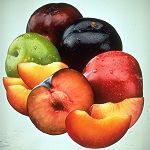|
|
 Plums are hard-pitted fruits like peachs, cherrys, almonds, and apricots.
About 12 plum species are cultivated throughout temperate regions for their
fruit and as flowering ornamentals.
Plums are hard-pitted fruits like peachs, cherrys, almonds, and apricots.
About 12 plum species are cultivated throughout temperate regions for their
fruit and as flowering ornamentals.
The common European plum, the most important species, has been cultivated since
ancient times and probably originated near the Caspian Sea. It was introduced
into North America, possibly by the Pilgrims, and is now mostly cultivated in
the western United States, California in particular. Fruits of varieties of
this species range in color from yellow or red to green, but purplish-blue is
most common. Dried plums, or prunes, are
made from the varieties that are richest in sugar and solids.
The Japanese plum, probably originating in China, was introduced into the
United States in 1870. The fruit is more pointed at the apex than that of the
common European plum, and its varieties are yellow or light red but never
purplish-blue. The Damson plum-a small, oval, sweet fruit used mostly in
jams-was first cultivated in ancient times in the region of Damascus.
How to Store:
Plums can be ripened by placing them in a paper bag, closing it loosely, and
leaving it on the counter for a few days. Once the fruit is ripe, it should be
stored in the refrigerator for up to three days.
Nutritional Facts:
· Low fat
· Saturated fat-free
· Sodium-free
· Cholesterol-free
· High in vitamin C
Detailed nutritional informatin can be found by searching the
USDA Nutritional Database
. Enter "Plum" (no quotes) as the keyword and select the
link and report of interest.
Scientific classification:
Plums belong to the genus Prunus of the
family Rosaceae. The common European plum is classified as Prunus domestica,
the Japanese plum as Prunus salicina, and the Damson plum as Prunus insititia.
|
|